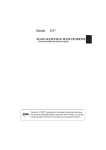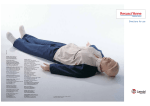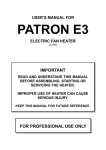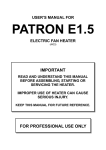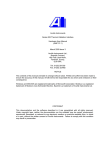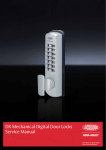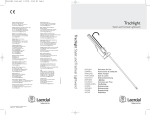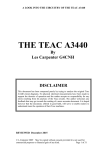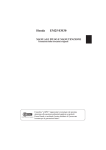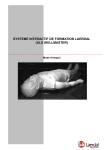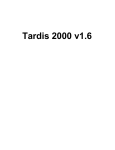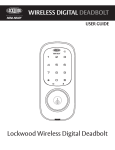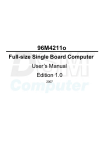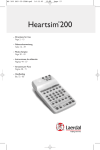Download Laerdal ALS Skillmaster
Transcript
Laerdal ALS Skillmaster Directions for Use Laerdal ALS Skillmaster CONTENTS Cautions and warnings Limited Warranty . . . . . . . . . . . . . . . . . . . . . . . . . . . . . . 2 Cautions and Warnings . . . . . . . . . . . . . . . . . . . . . . . . 2 1. Main Components . . . . . . . . . . . . . . . . . . . . . . . . . . 3 • Do not connect the product to a patient. • Use of a defibrillator for training purposes represents an operational hazard equivalent to use of a defibrillator on a real patient since it involves the release of high levels of electrical energy into the training manikin. Consequently: – All safety precautions for use of defibrillators must be followed, as if the manikin were a patient. Consult the user's manual of the defibrillator being used. – Defibrillation should be performed on the defibrillation connectors only. If defibrillation is performed over one or more of the ECG connectors, high voltages may be present on the remaining connectors during the shock. – To prevent overheating do not provide more than three defibrillator discharges (max 360 J) in a sequence. Do not exceed an average of two defibrillator discharges per minute during the training session. – The manikin must not be in contact with electrically conducting surfaces or objects during defibrillation. – A flame supporting atmosphere, for example with a high content of oxygen, should be avoided during defibrillation. – The manikin chest must be kept dry. – To prevent chest skin electrode pitting do not apply conductive gel, or conductive defibrillation pads intended for patient use. – Do not use cables or connectors with visible damage. Undo load sensor box with cables and ship chest skin with load sensor box for authorized Laerdal service. – Do not spill fluids over any component inside the manikin torso, since this could damage the unit and might also present a possible hazard for the operator. 2. System Features . . . . . . . . . . . . . . . . . . . . . . . . . . . . 4 3. Getting Started . . . . . . . . . . . . . . . . . . . . . . . . . . . . . 7 4. Maintenance and Repair. . . . . . . . . . . . . . . . . . . . . 8 5. Technical Data . . . . . . . . . . . . . . . . . . . . . . . . . . . . . 10 6. Parts List. . . . . . . . . . . . . . . . . . . . . . . . . . . . . . . . . . .11 Limited Warranty Laerdal Medical warrants to the purchaser that its products are free from defects in material and workmanship for a period of one (1) year from the date of purchase by the original user. During the designated one (1) year period, Laerdal Medical will, upon receipt of a product found to be defective due to materials or workmanship from the purchaser and notification in writing of the defect at its option repair or replace any parts found to be defective or the entire product. Products found to be defective and notification of defects may also be sent to the authorized Laerdal Medical dealer from whom the product was purchased. All postage, shipping, or handling charges shall be the sole responsibility of the purchaser. Laerdal Medical is responsible for the effects of safety, reliability and performance of its product(s) only if: • If a training session has included administering of drugs into the left arm, undo and empty the arm immediately after the training session. – service, repair, readjustment or modification is carried out by Laerdal Medical or persons authorized by Laerdal Medical. • Do not allow the manikin's skin to come in direct contact with ink or photocopied paper, as this can cause permanent stains on the skin. Also avoid using coloured plastic gloves when handling the manikin, as this may cause discolouration of the manikin's skin. – the electrical installation of the room where the product is used complies with pertinent national requirements. – the product is used in the proper manner in strict compliance with its Directions for use. • This device generates, uses and can radiate radiofrequency energy. If it is not installed and used in accordance with the instructions, it may cause harmful interference to radio communications. In that case the user is encouraged to try to correct the interference by: - Reorienting or relocating the receiving antenna. - Increasing the distance between the device and receiver. - Connecting the device into an outlet on a circuit different from that to which the receiver is connected. - Consulting the dealer or an experienced radio/TV technician for help. Laerdal Medical shall not be liable under this warranty for incidental or consequential damages or in the event any unauthorized repairs or modifications have been made or attempted or when the product, or any part thereof, has been damaged by accident, misuse or abuse. This warranty does not cover batteries, fuses, normal wear and tear, staining, discoloration or other cosmetic irregularity which does not impede or degrade product performance. Some states in the USA do not allow the exclusion or limitation of incidental or consequential damages, so those limitations or exclusions may not apply to you. There are no other express or implied warranties, whether of merchantability, fitness or purpose, or otherwise, on the product, its parts and accessories. 2 Laerdal ALS Skillmaster I1n.t rMoadiunc C t ioom nponents A B The Laerdal Skillmaster ALS Interactive Training System consists of the following main components: B. Heartsim 4000 This is the instructor's tool to control the training scenario, it requires a IBM compatible computer: A. ALS Skillmaster Manikin A full Torso male manikin allowing the simulation of Advanced Life Support skills to develop both individual and team skills. Features are listed below. The computer connects to the manikin via the Laerdal Link Box. Only one lead goes to the manikin which combines power input and connectivity to the Laerdal Link Box. Features are listed below. Head: - Intubation - nasal and oral - Head tilt (with sensor feedback*) - Jaw thrust (with sensor feedback*) - Audible feedback if pressure exerted on the teeth during intubation - Laryngospasm simulation - Bilateral carotid pulses with normal, weak and absent settings.* CD ROM: - ALS training controls via computer keyboard and/or remote control. - Over 2,500 ECG rhythm variations - Variable extrasystole rate - Choice of different extrasystole types - Variable pacemaker threshold (external pacemaker training only) - Control of manikin functions - Sounds - Breathing - Moaning - Vomiting - Left/right or bilateral lung obstruction - Pulse strength - Activity log - Scenario builder / ECG sequence builder for your own training scenarios - ECG Simulator as a stand alone training tool - ECG rhythm recognition quiz - VF recognition quiz - CPR performance curves and evaluation Torso: - Bilateral lungs - Auscultation of breath sounds - Left/right- or bilateral lung obstruction* - Chest compression sensors* - Precordial thump sensors* - 3/4 lead ECG monitoring* - ECG monitoring via defibrillation connectors* - Defibrillation connectors for AED or Manual defibrillation* - External pacemaker training* - Stomach Arms: - Volume infusion into left arm - Intravenous cannulation sites in right arm Link Box - 3/4 lead ECG connectors for ECG training - power in for the Laerdal ALS Skillmaster manikin - Remote Control Interface * Heartsim 4000 is required 3 Laerdal ALS Skillmaster 2 I n. t S ro yd s tu ec m t i oFne a t u r e s 2.1. Manikin Features: Laryngospasm: The instructor can simulate laryngospasm by using the syringe next to the head. 2.1.1 The head Head tilt: If the head tilt angle is greater than 27 degrees, and Airway Obstruction is not activated, the airway valves will be open. 2.1.2 Airways and lungs The manikin contains two lungs with separate volume detection. Maximum volume per lung is 1000 ml. Jaw thrust: If jaw thrust is performed, and Airway Obstruction is not activated, the airway valves will be open. The system is not developed to perform PEEP controlled ventilation. Please note that thorough cleaning of the upper airways, as well as changing the lungs, is necessary if mouth-tomouth or mouth-to-nose ventilation has been performed on the manikin. See sections 4.3, 4.5. and 4.6. Carotid pulse: When the manikin is used with the Heartsim 4000, a bilateral, palpable carotid pulse synchronous to the simulated ECG is generated, the pulse is alterable via the Heartsim 4000 for 3 strengths: Normal, Weak, Absent. Care should be taken when palpating the carotid pulse so as not to use excessive force as this will result in no pulse being felt. 4 Laerdal ALS Skillmaster Introduction 2.1.6 Stomach The manikin is equipped with a stomach, which will be distended at inspiratory pressures of more than 25 mm Hg, or if the manikin is ventilated after intubation into oesophagus. To expel the air after a stomach distention, place your hand on top of the manikin's stomach and press downwards. 2.1.3 Intubation The manikin is intubatable. The instructor can indicate that intubation has been performed. This will cause the airways to stay open, even if the head is tilted less than 27 degrees, and jaw thrust is not performed. If the manikin is intubated too deeply, the tube will pass into the right bronchus and cause only the right lung to be ventilated. 2.1.7 Chest compressions The manikin demonstrates the correct anatomical landmarks for external chest compressions. 2.1.4 Airway obstruction Airway obstruction can be induced from the Heartsim 4000. It will cause left/right or complete blocking of airways by shutting the magnetic valves that control air passage to each lung. A very fast depression of the sternum with a depth of more than 2 mm will be recorded as a precordial thump. 2.1.5 Opening and closing of airways The airways are opened and closed by two magnetic airway valves located inside the manikin body. The opening and closing of these valves are controlled through the following algorithm: a) – If Airway Obstruction is introduced, the airways are closed, regardless of intubation, head tilt or jaw thrust. – If the airways are not obstructed, the ALS Skillmaster will check the next step. b) – If the manikin is intubated, and this is indicated by the instructor on the Heartsim 4000, the airways are open, regardless of head tilt or jaw thrust. c) – If head tilt or jaw thrust is sufficient, the airways are open. – If head tilt or jaw thrust is not sufficient, the airways are closed. 5 Laerdal ALS Skillmaster Introduction 2.1.10 Pacing The manikin can be externally paced via the defibrillation connectors. The pacing threshold is variable and is set by the instructor via the Heartsim 4000. 2.1.11 Sound The manikin can make 3 sounds controlled by the instructor via the Heartsim 4000: - breathing - moaning - vomiting 2.1.8 ECG monitoring The manikin is equipped with separate defibrillation and ECG monitoring connectors. The system provides 3 lead ECG reading (lead I, II, III). 2.1.12 Arms Left Arm In the left arm, standard catheters can be positioned in either of the three pre-made holes. The hole on the back of the hand is sealed, and needs to be pierced before first time use. This solution has been chosen to provide optimum liquid storage capacity in the arm for users who do not require using this hole. Caution: These connectors are designed for ECG monitoring only. If defibrillation is attempted over any of the ECG connectors, it may cause high voltages to be present on one or more of the uncovered connectors during the shock. See the "Cautions and Warnings" section. Defibrillation attempt will also damage the internal electronics which may have to be replaced. Realistic drug dosages can be given. The left arm is a hollow reservoir that can collect injected fluid. After the training session, the arm can be dismounted and emptied through the drain plug located on the back of the shoulder. The hole on the wrist allows simulated drawing of samples for blood gas analysis. This hole is also sealed when the manikin is new, and needs to be pierced before using it for the first time. A blood pressure cuff can be positioned on the arm. Right Arm The right arm is a Laerdal IV Arm, which is also available separately (cat. No. 09 00 21). There are two main IV access areas on the Laerdal IV Arm: On the back of the hand, and at the antecubital fossa (ACF) on the upper arm. To gain IV access in these two areas, specially designed soft pads can be placed in the recesses of these two locations. The pads are pre-filled with blood and can be used for practice immediately after unpacking and assembly. There are two types of pads for the arm; one pad to fit onto the back of the hand, and one to fit into the antecubital fossa. 2.1.9 Defibrillation The manikin is equipped with two defibrillation connectors. The ECG signal can also be monitored across these connectors. The instructor can via the Heartsim 4000 use the Ignore Defib function to choose whether or not the defibrillation shall result in conversion to a perfusing rhythm. The hand can be turned 180 degrees from palm facing down to palm facing up to obtain the best position for IV access in the hand. Manual paddle adapters are supplied for use with manual defibrillators. The shoulder link allows for upwards and sideways movement of the arm. Caution: Defibrillation must be performed over these two connectors only. See the "Cautions and Warnings" section on page 3. 6 Laerdal ALS Skillmaster 3 I n. t G r oe dt u t icntgi oSnt a r t e d 3.2. Connection to the Heartsim 4000 One lead into the manikin provides all power and data communication. Unpack the Heartsim 4000 "Link" and connect this to the main power and the computer. Connect the manikin lead to the "Link". NB. Do not start the Heartsim 4000 program on the computer until all manikin or Link connections have been made. 3.1. Assembling the manikin Unpack the manikin and the arms from the case. Place the manikin on a surface and attach the arms to the shoulder attachments. Make sure that the arms are pushed into place before they are lowered The procedure to put the IV pads in place is the same for both types of pads: Unpack the pad from its carton. Snap the pad into place into the recess in the arm that has the shape corresponding to the pad Fold up the lower part of the stomach skin and attach the lower body to the two pegs on the torso. Fold back the stomach skin and pull up the trouser waistband. 7 Laerdal ALS Skillmaster 4 I n. t M r oadi n u tcet n i oann c e a n d R e p a i r A cleaning kit for the upper airways is included with the product. Spare lower airways, a stomach bag and a replacement IV pad of each type are also included. 4.2 Opening the manikin Lift up the edge of the skin on the side of the manikin. Unsnap the clips connecting the rib piece to the back portion. When all four clips have been loosened, carefully lift up the chest and fold it to the manikin's right side. Note: Wear gloves during cleaning. Vinyl gloves are recommended as latex gloves may stain the manikin skin. 4.1 Proper care of the Laerdal IV Arm 4.1.1 Maintenance tips - When withdrawing a catheter from the pad, press a cotton or gauze pad over the point of venipuncture. This will limit the amount of blood stain on the skin of the pad. - Use gloves when handling the IV Arm. This will reduce the risk of staining the pads. - To remove stains from simulated blood on the pads, wipe the pads in lukewarm water and allow them to dry. 4.3 Replacing lungs Pull out the stomach pad and stomach plate. 4.1.2 Refilling pads with simulated blood The artificial skin and veins are designed to self-seal after withdrawal of a needle or catheter. However, since the volume inside the enclosed veins is limited, it is sometimes necessary to replace blood that is lost during practice or when "flash back" is insufficient. A 250 ml bottle of simulated blood is enclosed with each Laerdal IV Arm. Simply fill a syringe with up to 1 ml of blood, and inject it carefully into any vein in the pad. This is best done after a successful cannulation before the removal of the cannula, to ensure that the blood enters the veins and not the surrounding "tissue". Be careful not to inject too much blood into the veins at once, since this will cause excessive pressure, leading to leakage of blood out through previous punctures in the veins. Unsnap the lung straps on either side of the chest plate and lift the chest plate up from its base. Apart from simple refilling, this technique can be used to simulate various degrees of blood pressure. 4.1.3 Replacing pads To replace a pad, first use the flat tool enclosed in the pack of the new pad to remove the old pad. Snap the new pad into the recess. 8 Laerdal ALS Skillmaster Introduction Disconnect the plastic tubes from the lower end of the magnetic airway valves. 4.4 Replacing stomach Disconnect the lower stomach tube from the lower end of the stomach valve. Undo the stomach bag by pushing the stomach tube from below upward through the hole in the stomach plate. Pull the tube up through the stomach plate. Loosen the plastic lungs from the chest plate by pushing the tubes from below upward through the holes in the chest plate. Lift off the lungs and pull the tubes through the chest plate. Unpack the new stomach. Insert the tube down through the hole in the stomach plate and reconnect it to the stomach valve. Snap the stomach bag in place on the stomach plate. Unpack the new lung set and guide the lung straps through the circular hole in the lungs. Note the colour marked on the tube, and insert the tubes into the holes marked with the same colour on the chest plate. Snap the lungs in place on the chest plate. Check with the illustration to make sure the lungs are correctly positioned, and not mounted upside down. To reposition the stomach plate, insert the peg at the upper end of the stomach plate into the slot under the chest plate, and then snap the lower end in place over the two steel pins. Connect the ends of the plastic tubes to the lower ends of the airway valves, so that the colour markings on the tubes and on the valves match. 4.5 Cleaning upper airways The head must be removed in order to clean the upper airways. First of all, open the manikin as described in section 4.2. Position the lung plate back into its base. Disconnect the upper airway tubes from the airway valves. Snap the lung straps back in place on both sides of the chest plate. Disconnect the stomach tube from the thick, transparent oesophageal tube. 9 Laerdal ALS Skillmaster Introduction Disconnect the thin tube connecting to the Y-piece in the neck. Use this setup to go through the following four steps, changing liquid in the container for each new step: 1. Use soapy water to remove condensation on interior surfaces. 2. Use clean water to remove soap residue. 3. Use disinfecting solution*. Allow airways to remain completely filled for at least 10 minutes. 4. Use clean water to remove disinfecting solution. Disconnect the cables from the sockets marked "Head" and "Head Pulse" (2) on the lower box inside the body. After each step lift the face clear of the liquid to allow drainage. Allow to dry completely before reconnecting head to manikin. 4.6 Cleaning airway valves Disconnect the upper and lower airway tubes from each of the valves. Turn the valve houses and lift out of their bases. Clean the valve houses using the 4 steps described in section 4.5, and allow to dry completely before placing them back in their bases. Gently turn the head around until it releases from the circular socket in the torso shell. Place the trainer's head face down, diagonally in the plastic sanitation kit container filled with liquid to a point just over the internal ridge. Attach stomach and lung connectors to the triple connector of the cleaning pump assembly. 5. Technical Data Supply voltage Supply voltage Link: Supply voltage Manikin: Physical dimensions Body, without legs and arms Dimensions: Weight: With legs and arms Dimensions: Put the free tube end into the container. Insert the cleaning syringe into the opening of the valve. Circulate liquid through the airways by pumping the syringe plunger. Weight:: Defibrillation/monitor electrodes Max. defibrillation voltage: Max. energy per shock: Max. average energy per minute: Min. energy per shock for defibrillation detection on defibrillation electrodes: Pacing detection: Environmental conditions Temperature Operating: Storage: Humidity: * A sodium hypochlorite solution prepared for single class use, is an effective and recommended disinfectant. This solution should have at least 500 ppm free available chlorine, i.e. >22 ml of 2.5 –5.0% household bleach per 500 ml of water. 100-240 VAC 50/60 Hz 9 VDC 2A max 80 x 40 cm (31 1/2 in. x 15 3/4 in.) 11.6 kg (25 1/2 lbs) 173 x 55 cm (68 1/8 in. x 21 5/8 in.) 15.8 kg (35 lbs) 5000 V 360 J 720 J (2 shocks per minute) 10 J 20 - 200 mA 15°C - 35°C (59°F - 95°F) 0°C - 50°C (32°F - 122°F) 15 - 90% RH (non-condensing) The serial number of each ALS Skillmaster is imprinted in the bottom plate of the torso, on the outer side, facing the lower body. The product is in compliance with essential requirements of council directive 89/366/EEC; EMC-directive. 10 USA and Latin America LAERDAL MEDICAL CORPORATION 167 Myers Corners Road, P.O. Box 1840 Wappingers Falls, New York 12590-8840 Telephone (800) 431-1055, (914) 297-7770 Telefax (800) 227-1143, (914) 297-1137 Canada LAERDAL MEDICAL CANADA LTD. 70 Ironside Cres., Unit #2 Scarborough, Ontario M1X 1G4 Tel. 1-800-265-9987, (416) 298-9600 Fax (416) 298-8016 United Kingdom LAERDAL MEDICAL LTD. Laerdal House, Goodmead Road, Orpington, Kent BR6 0HX Tel. 01689 876634, Fax 01689 873800 Germany LAERDAL D-81249 München, Am Loferfeld 56 Telefon: 089 / 864 20 00 Telefax: 089 / 864 34 84 France LAERDAL MEDICAL FRANCE S.A. Silic n° 5 - 1 rue des Vergers - 69760 Limonest Tél. 04 72 52 02 52, Fax 04 78 35 38 45 Italy LAERDAL ITALIA S.R.L. Via dei Lapidari, 13 40129 Bologna Tel. 051-320087, Fax 051-320137 Spain LAERDAL ESPAÑA, S.L. Manuel Tovar 19 28034 Madrid Tel.( 91)-7291110, Fax (91)-7291125 Benelux LAERDAL BENELUX N.V. Business Park Luchthavenlaan, Jan Olieslagerslaan 33, B-1800 Vilvoorde Tel. 32-2-253 36 96, Fax 32-2-253 36 90 Australia LAERDAL Pty. Ltd. (ACN 003 817 490) 23 Edward Street, Huntingdale, Victoria 3166 Tel. (03) 61 3 9569 4055, Toll free 1800 331 565 Fax (03) 61 3 9569 4028, Toll free 1800 635 835 Far East LAERDAL Far East Rep. Office, 7A Dalhousie Lane, Singapore 209676 Tel. 292 2880, Fax 292 3212 Sweden LAERDAL MEDICAL AB Box 2064, 132 02 Saltsjö-Boo Tel. 08-7150300, Fax 08-7471648 Finland LAERDAL OY Vattuniemenranta 2, 00210 HELSINKI Puhelin 09 - 692 77 22, Tilaukset 09 - 692 76 22 Telekopio 09 - 692 77 99 Denmark LAERDAL DANMARK Postbox 109, DK-8883 GJERN Tel. 80 333 112, Fax 80 333 555 Norway LAERDAL P.O. Box 377, N-4001 Stavanger Tel. 51 51 17 00, Fax 51 52 35 57 6644 rev A Printed in Norway e-mail:[email protected].












